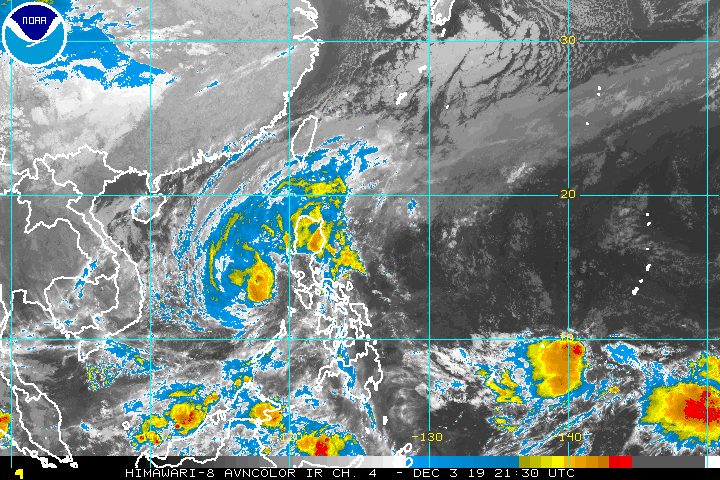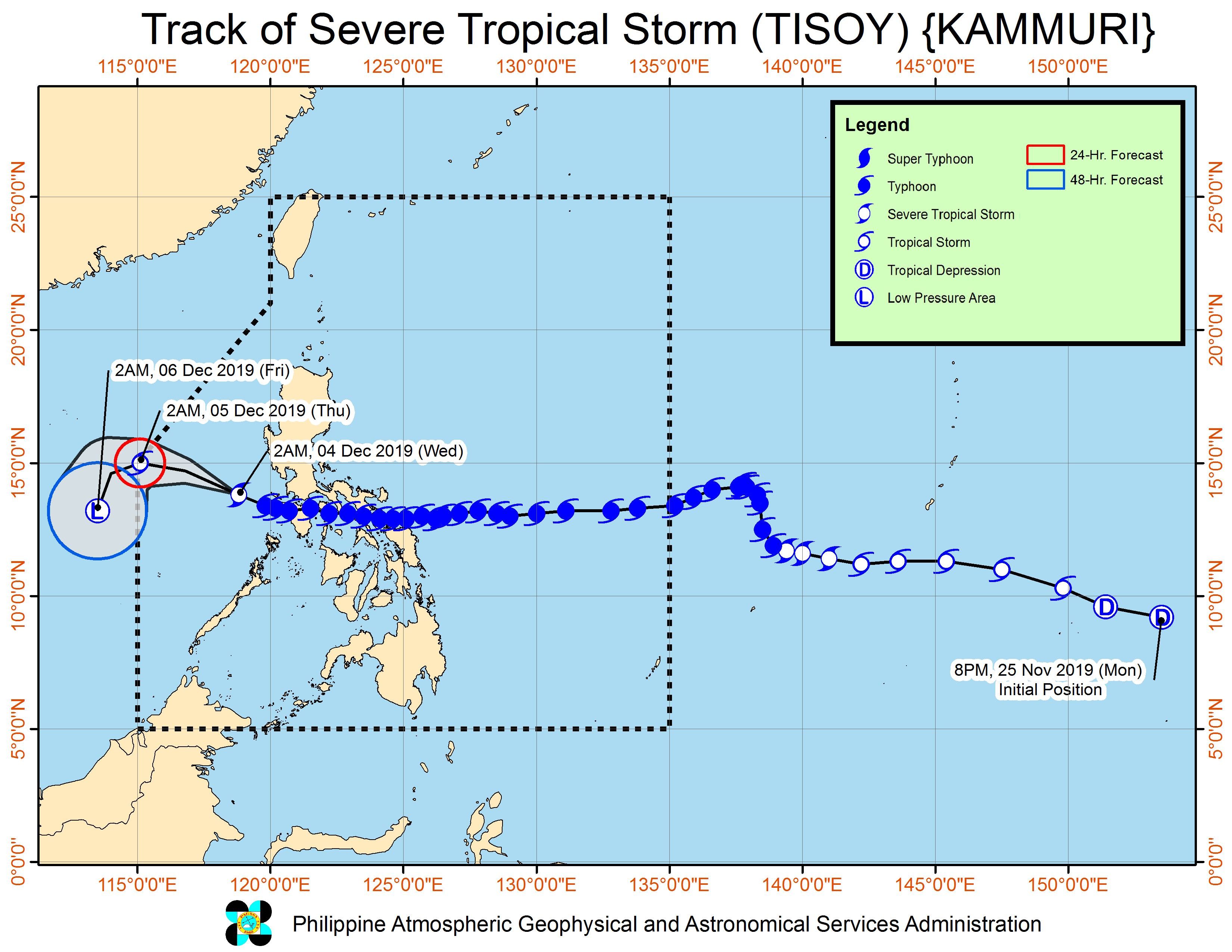SUMMARY
This is AI generated summarization, which may have errors. For context, always refer to the full article.

What’s the weather like in your area? Tweet us at @rapplerdotcom.
MANILA, Philippines – Tisoy (Kammuri) weakened from a typhoon into a severe tropical storm before dawn on Wednesday, December 4, as it continued to move away from the Philippines.
In a briefing past 5 am on Wednesday, the Philippine Atmospheric, Geophysical, and Astronomical Services Administration (PAGASA) said Severe Tropical Storm Tisoy is already 275 kilometers west northwest of Calapan City, Oriental Mindoro, or 195 kilometers west southwest of Subic, Zambales.
It slightly accelerated, now moving west northwest at 20 kilometers per hour (km/h) from the previous 15 km/h.
Tisoy now has maximum winds of 100 km/h from the previous 120 km/h and gustiness of up to 125 km/h from the previous 150 km/h.
PAGASA said Tisoy is expected to continuously weaken due to the northeast monsoon or hanging amihan, which is cold air. Warm air fuels tropical cyclones. (READ: FAST FACTS: Tropical cyclones, rainfall advisories)
Tisoy earlier brought fierce winds and heavy rain as it made landfall 4 times in the country.
- Gubat, Sorsogon – 11 pm on Monday, December 2
- San Pascual, Burias Island, Masbate – 4 am on Tuesday, December 3
- Torrijos, Marinduque – 8:30 am on Tuesday, December 3
- Naujan, Oriental Mindoro – 12:30 pm on Tuesday, December 3
The region of Bicol was hard hit. In Albay, hundreds of families were left homeless, while the Legazpi City Domestic Airport sustained heavy damage.
Flooding and damage were also reported in Samar Island.
Now, there are fewer areas under tropical cyclone wind signals. Signal No. 3 has also been lifted, and some areas have been downgraded from Signal No. 2 to No. 1, like Metro Manila. (READ: Why is it now called tropical cyclone ‘wind’ – and not ‘warning’ – signals?)
Signal No. 2 (winds of 61 km/h to 120 km/h)
- southern part of Zambales (Castillejos, Olongapo City, San Antonio, San Felipe, San Marcelino, San Narciso, Subic)
- Bataan
- western part of Cavite (Alfonso, General Emilio Aguinaldo, Magallanes, Maragondon, Ternate)
- western part of Batangas (Calaca, Balayan, Tuy, Calatagan, Lian, Nasugbu)
- northwestern part of Occidental Mindoro including Lubang Island (Abra de Ilog, Looc, Lubang, Mamburao, Paluan)
Signal No. 1 (winds of 30 km/h to 60 km/h)
- Metro Manila
- western part of Quezon (Dolores, Tiaong, Candelaria, Sariaya, San Antonio)
- Laguna
- Rizal
- rest of Batangas
- rest of Cavite
- northern part of Palawan including Calamian Islands (El Nido, Coron, Busuanga, Culion, Linapacan)
- southwestern part of Bulacan (Calumpit, Hagonoy, Paombong, Malolos City, Bulakan, Obando, Meycauayan City, Marilao, Bocaue, Balagtas, Guiguinto, Plaridel, Pulilan, Baliuag, Bustos, Pandi, Sta Maria, San Jose del Monte City)
- western part of Pampanga (Mabalacat City, Angeles City, Porac, Floridablanca, Lubao, Guagua, Sta Rita, Bacolor, San Fernando City, Sto Tomas, Minalin, Macabebe, Sasmuan, Masantol, Apalit, San Simon)
- western part of Tarlac (Mayantoc, San Jose, Capas, Bamban)
- rest of Zambales
- Oriental Mindoro
- rest of Occidental Mindoro
PAGASA said that aside from areas still under tropical cyclone wind signals, other parts of Northern Luzon, Central Luzon, Calabarzon, and Mimaropa may experience gusty conditions as well, but due to the northeast monsoon.
When it comes to rainfall, most areas are seeing improvement on Wednesday. The following are the only places included in PAGASA’s latest rainfall outlook:
Moderate rain with occasional heavy rain
- Ilocos Region
- Cagayan Valley
- Cordillera Administrative Region
- Aurora
Flash floods and landslides, however, are possible.
Travel is still risky too, especially for small vessels, in the seaboards of areas under tropical cyclone wind signals, the seaboards of Northern Luzon, the eastern seaboard of Central Luzon, and the eastern and western seaboards of Southern Luzon.
The Philippine Coast Guard earlier said more than 7,000 passengers were stranded at the height of Tisoy’s onslaught.
Hundreds of domestic and international flights to and from the Philippines were also canceled. In Metro Manila, the Ninoy Aquino International Airport was closed for 7 hours on Tuesday, December 3, then reopened earlier than scheduled for recovery flights.
Class suspensions were again announced for Wednesday. (READ: #WalangPasok: Class suspensions, Wednesday, December 4, 2019)
Tisoy also disrupted some events of the 2019 Southeast Asian Games, which were either held earlier or postponed. But organizers said the regional meet will wrap up as scheduled next Wednesday, December 11.
Based on its latest forecast track, Tisoy is expected to leave the Philippine Area of Responsibility between Wednesday evening and Thursday morning, December 5.

Tisoy is the Philippines’ 20th tropical cyclone for 2019. (READ: LIST: PAGASA’s names for tropical cyclones in 2019)
The country gets an average of 20 tropical cyclones annually. In the earlier part of the year, only 14 to 18 tropical cyclones had been projected since 2019 is an El Niño year.
For the month of December, PAGASA had been expecting 0 to 1 tropical cyclone.
PAGASA declared the start of the rainy season last June 14. – Rappler.com
Add a comment
How does this make you feel?
There are no comments yet. Add your comment to start the conversation.